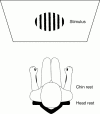Elevated visual motion detection thresholds in adults with acquired ophthalmoplegia
- PMID: 11734519
- PMCID: PMC1723795
- DOI: 10.1136/bjo.85.12.1447
Elevated visual motion detection thresholds in adults with acquired ophthalmoplegia
Abstract
Aims: To test the hypothesis that in patients with acquired chronic bilateral ophthalmoplegia, abnormal retinal image slippage during head movements would result in abnormal thresholds for visual perception of motion.
Methods: Five patients (two males and three females) with ophthalmoplegia were included in the study. The average age was 44 years (range 30-69 years). The aetiology of ophthalmoplegia was myasthenia gravis (MG; n=2), chronic progressive external ophthalmoplegia (CPEO; n=2), and chronic idiopathic orbital inflammation. Visual motion detection thresholds were assessed using horizontal and vertical gratings (spatial frequency) set at thresholds for visibility. The grating was then accelerated at 0.09 deg/s(2). The subject's task was to detect the drift direction of the stimulus.
Results: Visual motion detection thresholds were raised to a mean of 0.434 deg/s (SD 0.09) (mean normal value 0.287 deg/s (SD 0.08)) for horizontal motion; and to a mean of 0.425 deg/s (SD 0.1) (mean normal value 0.252 deg/s (SD 0.08)) for vertical motion. The difference in values for both horizontal and vertical motion detection were statistically significant when compared with age matched controls; p <0.023 for horizontal motion and p<0.07 for vertical motion (two tailed t test).
Conclusion: Abnormally raised visual motion thresholds were found in patients with ophthalmoplegia. This may represent a centrally mediated adaptive mechanism to ignore excessive retinal slip and thus avoid oscillopsia during head movements.
Figures
Similar articles
-
Vestibular perception in patients with acquired ophthalmoplegia.Neurology. 2003 Jun 24;60(12):1993-5. doi: 10.1212/01.wnl.0000067992.17185.60. Neurology. 2003. PMID: 12821750
-
Visual motion detection in patients with absent vestibular function.Vision Res. 2003 Jun;43(14):1589-94. doi: 10.1016/s0042-6989(03)00218-9. Vision Res. 2003. PMID: 12782072
-
Visual processing during high frequency head oscillation.Aviat Space Environ Med. 1996 Jul;67(7):625-32. Aviat Space Environ Med. 1996. PMID: 8830941 Clinical Trial.
-
Ptosis Correction.2023 Jul 10. In: StatPearls [Internet]. Treasure Island (FL): StatPearls Publishing; 2025 Jan–. 2023 Jul 10. In: StatPearls [Internet]. Treasure Island (FL): StatPearls Publishing; 2025 Jan–. PMID: 30969650 Free Books & Documents.
-
Reduced duration of a visual motion aftereffect in congenital nystagmus.Doc Ophthalmol. 1998-1999;95(3-4):301-14. doi: 10.1023/a:1001860524648. Doc Ophthalmol. 1998. PMID: 10532412
Cited by
-
Motion sensitivity during fixation in straight-ahead and lateral eccentric gaze.Exp Brain Res. 2008 Sep;190(2):189-200. doi: 10.1007/s00221-008-1462-1. Epub 2008 Jun 27. Exp Brain Res. 2008. PMID: 18584163
-
Symptomatic Recovery in Miller Fisher Syndrome Parallels Vestibular-Perceptual and not Vestibular-Ocular Reflex Function.Front Neurol. 2011 Feb 11;2:2. doi: 10.3389/fneur.2011.00002. eCollection 2011. Front Neurol. 2011. PMID: 21350734 Free PMC article.
-
Development of a Spatio-temporal Contrast Sensitivity Test for Clinical Use.J Ophthalmic Vis Res. 2022 Jan 21;17(1):69-77. doi: 10.18502/jovr.v17i1.10172. eCollection 2022 Jan-Mar. J Ophthalmic Vis Res. 2022. PMID: 35194498 Free PMC article.
-
Blind(fold)ed by science: a constant target-heading angle is used in visual and nonvisual pursuit.Psychon Bull Rev. 2013 Oct;20(5):923-34. doi: 10.3758/s13423-013-0412-5. Psychon Bull Rev. 2013. PMID: 23440726 Clinical Trial.
References
MeSH terms
Grants and funding
LinkOut - more resources
Full Text Sources

